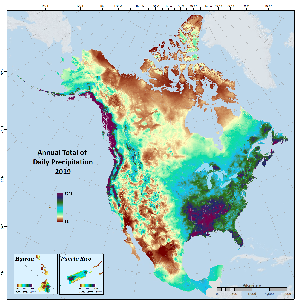Michele Thornton and co-authors, Rupesh Shrestha, Peter Thornton, Shih-Chieh Kao, Yaxing Wei, and Bruce Wilson of ORNL have evaluated precipitation and temperature bias in surface gauge data and are advancing methodologies to address data fusion techniques to improve precipitation occurrence in Daymet.
If you are attending ESA, be sure to check out their poster, Improvements in daymet continental-scale gridded daily temperature and precipitation estimates in PS 48 - Big Data in Ecology: Methods and Tools.
Daymet provides high-resolution daily gridded weather parameters for the entire North American spatial extent for the time period 1980 – 2019 (https://daymet.ornl.gov/). The Daymet processing model relies on daily reported maximum temperature, minimum temperature, and precipitation from a unified database of daily climate observations from land surface stations across North America. Daily observations are obtained from the National Centers for Environmental Information (NCEI) Global Historical Climatology Network (GHCN)-Daily database. These data are integrated from numerous sources and subjected to a common suite of quality assurance reviews. Ideally, these input data would be regular in their recording methodologies and time of observation, but inconsistencies exist due to the various sources of data which today include approximately 30,000 volunteers across North America from two important groups; the National Weather Service (NWS) Cooperative Observer Program (COOP) and the Community Collaborative Rain, Hail and Snow (CoCoRaHS) Network.
We evaluate and report Daymet model results for temperature and precipitation time-of-observation bias in the surface weather observation network. In addition to bias, we used radar-based hourly NCEP Stage IV QPE to evaluate the improvements of precipitation event timing. We also used a novel cross-validation analysis to assess and apply a correction to instrumentation bias in high-elevation reporting stations.
These improvements will be available in a late 2020 release of Daymet V4 daily meteorological data for North America for year 1980 – present.

